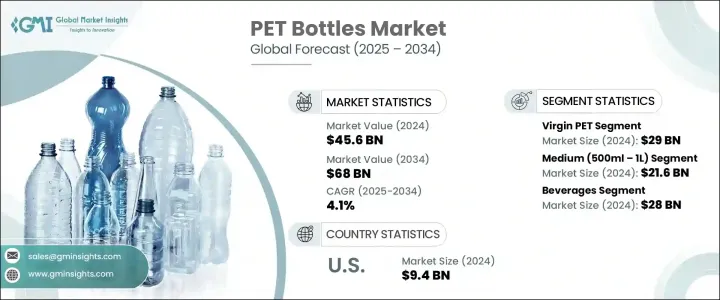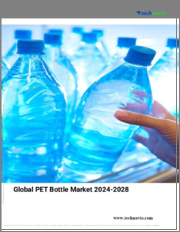
|
시장보고서
상품코드
1755195
PET병 시장 기회와 촉진요인, 업계 동향 분석 및 예측(2025-2034년)PET Bottles Market Opportunity, Growth Drivers, Industry Trend Analysis, and Forecast 2025 - 2034 |
||||||
세계의 PET 병 시장은 2024년에는 456억 달러로 평가되었으며 CAGR 4.1%를 나타내 2034년에는 680억 달러에 이를 것으로 추정됩니다.
이 성장을 뒷받침하는 주요 요인은 퍼스널케어 및 위생 용도에서의 채용이 증가하는 한편, 주로 물이나 무알코올 음료 등 포장된 액체의 소비가 증가하고 있다는 것입니다. 이 병은 강도, 재활용성, 투명성, 저렴한 가격의 균형에서 매우 선호되고 있으며, 일부 소비자층에서 이상적입니다.

PET 포장의 상황은 과거의 규제 상황의 변화로도 큰 영향을 받고 있습니다. 혹은 현지 생산을 강화하도록 촉구되었습니다. 그 결과, 비용의 변동은 장기적인 투자를 억제하고, 조달 전략을 변경해, 식품, 음료, 의약품의 포장 시장에 있어서 경쟁 역학을 재구축했습니다.
| 시장 범위 | |
|---|---|
| 시작 연도 | 2024년 |
| 예측 연도 | 2025-2034년 |
| 시작 금액 | 456억 달러 |
| 예측 금액 | 680억 달러 |
| CAGR | 4.1% |
재료별로는 버진 PET, 재생 PET(rPET), 바이오 PET, PETG로 구분됩니다. 버진 PET는 광범위하게 이용 가능하며 고급 제조 시스템에 적합한 것으로 알려져 있으며, 다양한 최종 사용자 분야에서 안정적인 품질과 고속 생산을 가능하게 하고 있습니다.
PET병은 용량별로 소형(500ml 미만), 중형(500ml-1리터), 대형(1리터 이상)으로 분류됩니다. 특히 바쁜 라이프 스타일이나 활동적인 소비자에게 적합합니다. 그 인기는 운반이 간단한 일회용 포장 수요가 계속 증가하고 있는 도시에서 현저하게 높아지고 있습니다. 또, 스페이스 효율과 제품의 시인성이 중요시되는 업계에서는 휴대성과 용적의 실용적인 밸런스를 제공하는 병으로서, 주력 상품이 되고 있습니다.
용도별로, PET병은 음료, 식품, 퍼스널케어 및 화장품, 의약품, 가정용·산업용 화학제품 분야에서 널리 사용되고 있습니다. 음료 분야는 2024년 280억 달러의 가치로 시장을 선도했습니다. PET 병은 보다 무거운 포장 형태를 대체하는 실용적인 옵션을 제공하며, 브랜드가 물류 비용을 줄이고 취급 효율성을 향상시키는 데 도움이 됩니다. 가벼운 특성은 비산 방지 및 재봉 가능성과 함께 제품의 안전성을 손상시키지 않고 편리성을 요구하는 현대 소비자에게 이상적입니다. 게다가, 일회용 유형으로 곧 마실 수 있는 음료에 대한 수요 증가가 도시나 이동 인구의 PET병 채용을 한층 더 밀어주고 있습니다.
지역별로는 미국이 세계의 PET병 시장에서 돌출한 지위를 차지하고 있으며, 2024년 매출은 94억 달러에 달했습니다. 이 나라에서는 웰빙, 퍼스널케어 및 식품 배달 분야에서 패키지 제품에 대한 안정적인 수요가 계속되고 있습니다. 소비자 직접 판매 및 전자상거래 플랫폼의 상승으로 안전하고 누출이 어려워 미관이 뛰어난 PET 포장 솔루션의 요구가 더욱 높아지고 있습니다. 또 국내 제조업체는 규제의 기대나 소비자의 환경 기호를 따르기 때문에 지속가능성을 중시한 혁신에 점점 힘을 가하게 되고 있습니다.
PET 병 분야의 경쟁 환경은 여전히 역동적이며 대규모 다국적 기업과 신흥 지역 기업이 혼재하고 있습니다. RPET 생산에 대한 강한 뒷받침으로 순환 포장 모델을 도입하는 노력이 격렬해지고 있습니다.
재료공학은 또한 산소와 자외선에 대한 노출에 대한 탁월한 보호를 제공하여 보존기간을 연장하고 제품의 무결성을 유지할 수 있는 보다 강화된 PET 변종에 대한 길을 열었습니다.
목차
제1장 조사 방법과 범위
제2장 주요 요약
제3장 업계 인사이트
- 생태계 분석
- 트럼프 정권에 의한 관세에 대한 영향
- 무역에 미치는 영향
- 무역량의 혼란
- 보복 조치
- 업계에 미치는 영향
- 공급측의 영향
- 주요 부품의 가격 변동
- 공급망 재구성
- 생산 비용에 미치는 영향
- 수요측의 영향(판매가격)
- 최종 시장에의 가격 전달
- 시장 점유율 동향
- 소비자의 반응 패턴
- 공급측의 영향
- 영향을 받는 주요 기업
- 전략적인 업계 대응
- 공급망 재구성
- 가격 설정 및 제품 전략
- 정책관여
- 전망과 향후 검토 사항
- 무역에 미치는 영향
- 업계에 미치는 영향요인
- 성장 촉진요인
- 용기 식수 및 음료 수요 급증
- 식품 및 음료 업계의 확대
- 의약품 포장에서의 사용 증가
- 퍼스널케어 업계에서의 채용 확대
- 배리어성과 보존 기간의 향상
- 업계의 잠재적 위험 및 과제
- 플라스틱 오염에 대한 환경 우려
- 원재료 가격 변동
- 성장 촉진요인
- 성장 가능성 분석
- 규제 상황
- 기술의 상황
- 향후 시장 동향
- 갭 분석
- Porter's Five Forces 분석
- PESTEL 분석
제4장 경쟁 구도
- 서론
- 기업의 시장 점유율 분석
- 주요 시장 기업의 경쟁 분석
- 경쟁 포지셔닝 매트릭스
- 전략 대시보드
제5장 시장 추계·예측 : 재료별(2021-2034년)
- 주요 동향
- 버진 PET
- rPET(재활용 PET)
- 바이오 PET
- PETG
제6장 시장 추계·예측 : 용량별(2021-2034년)
- 주요 동향
- 소형(500ml 미만)
- 중형(500ml-1L)
- 대형(1L 이상)
제7장 시장 추계·예측 : 용도별(2021-2034년)
- 주요 동향
- 음료
- 식품 포장
- 퍼스널케어 및 화장품
- 의약품
- 가정용 및 산업용 화학약품
제8장 시장 추계·예측 : 지역별(2021-2034년)
- 주요 동향
- 북미
- 미국
- 캐나다
- 유럽
- 독일
- 영국
- 프랑스
- 스페인
- 이탈리아
- 네덜란드
- 아시아태평양
- 중국
- 인도
- 일본
- 호주
- 한국
- 라틴아메리카
- 브라질
- 멕시코
- 아르헨티나
- 중동 및 아프리카
- 사우디아라비아
- 남아프리카
- 아랍에미리트(UAE)
제9장 기업 프로파일
- ALPLA Group
- Amcor plc
- Berry Global Inc.
- Esterform Ltd
- GTX HANEX Plastic Sp. z oo
- Indorama Ventures Public Company Limited.
- JSK Plastic Industries
- Kee Pet Containers
- Resilux
- Retal Industries LTD.
- SABIC
- Sidel
- Silgan Plastics
- Taiwan Hon Chuan
- TEKNOBYTE INDIA PVT. LTD.
The Global PET Bottles Market was valued at USD 45.6 billion in 2024 and is estimated to grow at a CAGR of 4.1% to reach USD 68 billion by 2034. A key driver fueling this growth is the increasing consumption of packaged liquids, primarily water and non-alcoholic beverages, alongside rising adoption across personal care and hygiene applications. Urbanization, rising disposable incomes, and evolving lifestyle trends continue to push the demand for portable, lightweight, and durable packaging solutions, with PET bottles emerging as a practical and cost-effective choice. These bottles are highly favored for their balance of strength, recyclability, transparency, and affordability, making them ideal across several consumer segments.

The PET packaging landscape has also been significantly influenced by past regulatory shifts. Tariffs imposed under previous US administrations-particularly on imports from China-created ripple effects across supply chains. Key raw materials, such as PET resin, became more expensive for domestic manufacturers, prompting them to seek alternate sources or ramp up local production. The resulting cost volatility discouraged long-term investments, altering procurement strategies and reshaping competitive dynamics within food, beverage, and pharmaceutical packaging markets. However, these challenges ultimately prompted innovation and increased focus on sustainability and domestic resilience.
| Market Scope | |
|---|---|
| Start Year | 2024 |
| Forecast Year | 2025-2034 |
| Start Value | $45.6 Billion |
| Forecast Value | $68 Billion |
| CAGR | 4.1% |
By material, the market is segmented into virgin PET, recycled PET (rPET), bio-PET, and PETG. Among these, virgin PET accounted for the highest share, valued at USD 29 billion in 2024. This dominance is largely due to its clear visual appearance, strong barrier capabilities, and reliable structural performance, which meet the standards of high-volume packaging applications. Virgin PET is also known for its wide availability and compatibility with advanced manufacturing systems, allowing for consistent quality and high-speed production across various end-user sectors. Its adaptability makes it the preferred material for companies requiring scalable and efficient bottling solutions.
In terms of capacity, PET bottles are classified into small (up to 500 ml), medium (500 ml to 1 liter), and large (more than 1 liter). The medium-sized segment emerged as the largest, recording a valuation of USD 21.6 billion in 2024. These bottles are increasingly favored for their convenience and ideal portion size, particularly suited to busy lifestyles and active consumers. Their popularity has grown significantly across urban regions, where demand for easy-to-carry, single-use packaging continues to rise. These bottles are also a mainstay in industries where space efficiency and product visibility are critical, offering a practical balance between portability and volume.
Application-wise, PET bottles are widely used in beverage, food, personal care and cosmetics, pharmaceuticals, and household and industrial chemical sectors. The beverage sector led the market with a value of USD 28 billion in 2024. PET bottles provide a practical alternative to heavier packaging formats, helping brands reduce logistical costs and improve handling efficiency. Their lightweight nature, combined with shatter resistance and resealability, makes them ideal for modern consumers looking for convenience without compromising product safety. In addition, the growing demand for single-use and ready-to-consume drinks has further bolstered the adoption of PET bottles across urban and mobile populations.
Regionally, the United States held a prominent position in the global PET bottles market, contributing USD 9.4 billion in revenue in 2024. The country continues to see steady demand for packaged products across wellness, personal care, and food delivery sectors. The rise of direct-to-consumer distribution and e-commerce platforms has further strengthened the need for secure, leak-resistant, and aesthetically appealing PET packaging solutions. Domestic producers are also increasingly focusing on sustainability-driven innovations to align with regulatory expectations and consumer environmental preferences.
The competitive environment in the PET bottles space remains dynamic, featuring a mix of large-scale multinational corporations and emerging regional players. Companies are channeling investments toward the development of eco-friendly solutions such as lightweight bottles, chemically recycled rPET, and biodegradable alternatives. Efforts to incorporate circular packaging models are intensifying, with a strong push towards closed-loop recycling, monomaterial formats, and food-grade rPET production. Technological enhancements have also led to the emergence of smart packaging features like digital markers and scannable labels, providing added value through traceability, consumer engagement, and better waste management practices.
Materials engineering has further paved the way for enhanced PET variants capable of offering superior protection against oxygen and UV exposure, thereby extending shelf life and preserving product integrity. With continuous innovation, evolving regulations, and shifting consumer behaviors, the PET bottles market is expected to witness sustained demand, especially across health-conscious and mobile-focused consumer groups.
Table of Contents
Chapter 1 Methodology and Scope
- 1.1 Market scope and definitions
- 1.2 Research design
- 1.2.1 Research approach
- 1.2.2 Data collection methods
- 1.3 Base estimates and calculations
- 1.3.1 Base year calculation
- 1.3.2 Key trends for market estimation
- 1.4 Forecast model
- 1.5 Primary research and validation
- 1.5.1 Primary sources
- 1.5.2 Data mining sources
Chapter 2 Executive Summary
- 2.1 Industry 3600 synopsis
Chapter 3 Industry Insights
- 3.1 Industry ecosystem analysis
- 3.2 Trump administration tariffs
- 3.2.1 Impact on trade
- 3.2.1.1 Trade volume disruptions
- 3.2.1.2 Retaliatory measures
- 3.2.2 Impact on the industry
- 3.2.2.1 Supply-side impact
- 3.2.2.1.1 Price volatility in key components
- 3.2.2.1.2 Supply chain restructuring
- 3.2.2.1.3 Production cost implications
- 3.2.2.2 Demand-side impact (selling price)
- 3.2.2.2.1 Price transmission to end markets
- 3.2.2.2.2 Market share dynamics
- 3.2.2.2.3 Consumer response patterns
- 3.2.2.1 Supply-side impact
- 3.2.3 Key companies impacted
- 3.2.4 Strategic industry responses
- 3.2.4.1 Supply chain reconfiguration
- 3.2.4.2 Pricing and product strategies
- 3.2.4.3 Policy engagement
- 3.2.5 Outlook and future considerations
- 3.2.1 Impact on trade
- 3.3 Industry impact forces
- 3.3.1 Growth drivers
- 3.3.1.1 Surging demand for packaged water & beverages
- 3.3.1.2 Expansion of the food & beverage industry
- 3.3.1.3 Increased use in pharmaceutical packaging
- 3.3.1.4 Growing adoption in personal care industry
- 3.3.1.5 Improved barrier properties & shelf life
- 3.3.2 Industry pitfalls and challenges
- 3.3.2.1 Environmental concerns over plastic pollution
- 3.3.2.2 Volatility in raw material prices
- 3.3.1 Growth drivers
- 3.4 Growth potential analysis
- 3.5 Regulatory landscape
- 3.6 Technology landscape
- 3.7 Future market trends
- 3.8 Gap analysis
- 3.9 Porter's analysis
- 3.10 PESTEL analysis
Chapter 4 Competitive Landscape, 2024
- 4.1 Introduction
- 4.2 Company market share analysis
- 4.3 Competitive analysis of major market players
- 4.4 Competitive positioning matrix
- 4.5 Strategy dashboard
Chapter 5 Market Estimates and Forecast, By Material type, 2021 - 2034 (USD Billion & Million metric tons)
- 5.1 Key trends
- 5.2 Virgin PET
- 5.3 rPET (Recycled PET)
- 5.4 Bio-PET
- 5.5 PETG
Chapter 6 Market Estimates and Forecast, By Capacity, 2021 - 2034 (USD Billion & Million metric tons)
- 6.1 Key trends
- 6.2 Small (<500ml)
- 6.3 Medium (500ml–1L)
- 6.4 Large (>1L)
Chapter 7 Market Estimates and Forecast, By Application, 2021 - 2034 (USD Million & Million metric tons)
- 7.1 Key trends
- 7.2 Beverages
- 7.3 Food packaging
- 7.4 Personal care & cosmetics
- 7.5 Pharmaceuticals
- 7.6 Household & industrial chemicals
Chapter 8 Market Estimates and Forecast, By Region, 2021 - 2034 (USD Million & Million metric tons)
- 8.1 Key trends
- 8.2 North America
- 8.2.1 U.S.
- 8.2.2 Canada
- 8.3 Europe
- 8.3.1 Germany
- 8.3.2 UK
- 8.3.3 France
- 8.3.4 Spain
- 8.3.5 Italy
- 8.3.6 Netherlands
- 8.4 Asia Pacific
- 8.4.1 China
- 8.4.2 India
- 8.4.3 Japan
- 8.4.4 Australia
- 8.4.5 South Korea
- 8.5 Latin America
- 8.5.1 Brazil
- 8.5.2 Mexico
- 8.5.3 Argentina
- 8.6 Middle East and Africa
- 8.6.1 Saudi Arabia
- 8.6.2 South Africa
- 8.6.3 UAE
Chapter 9 Company Profiles
- 9.1 ALPLA Group
- 9.2 Amcor plc
- 9.3 Berry Global Inc.
- 9.4 Esterform Ltd
- 9.5 GTX HANEX Plastic Sp. z o.o.
- 9.6 Indorama Ventures Public Company Limited.
- 9.7 JSK Plastic Industries
- 9.8 Kee Pet Containers
- 9.9 Resilux
- 9.10 Retal Industries LTD.
- 9.11 SABIC
- 9.12 Sidel
- 9.13 Silgan Plastics
- 9.14 Taiwan Hon Chuan
- 9.15 TEKNOBYTE INDIA PVT. LTD.



















